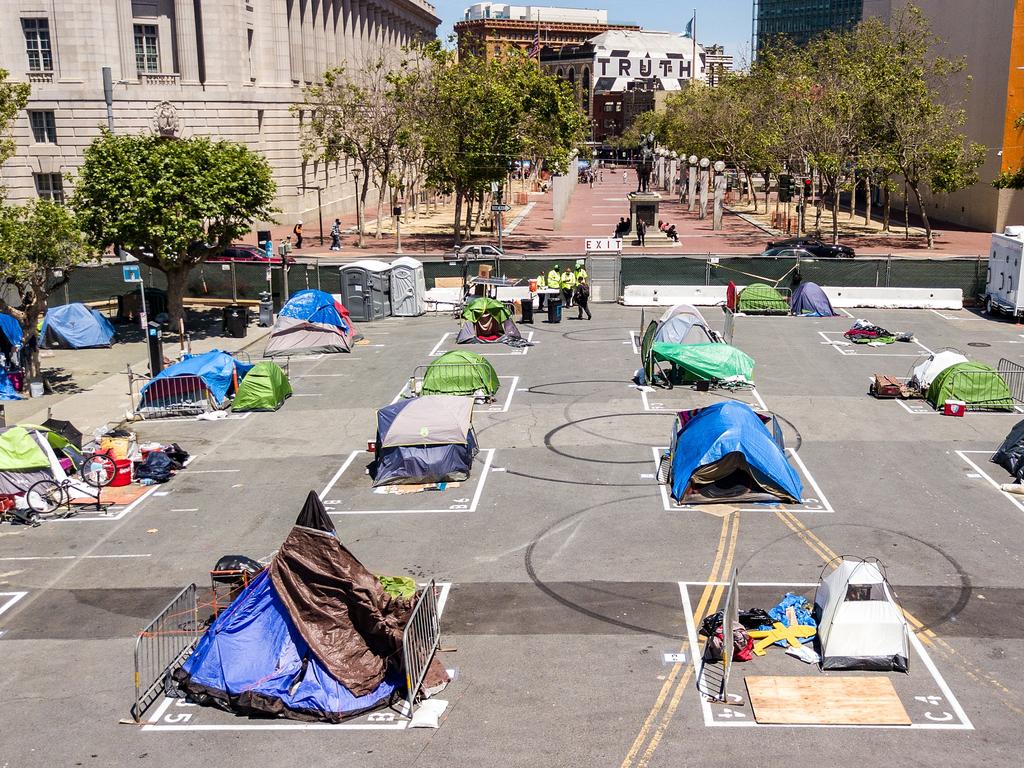How surging Los Angeles housing wealth has supercharged the city’s homelessness problem
A dash of welcome Australian charity at ground zero for American homelessness is up against a chronic problem: ever rising house prices.

Taking bus No.33 from the glamorous Venice Beach enclave to Skid Row in downtown Los Angeles is a descent into a shocking dystopia of filth and human decay, and a microcosm of the all too obvious racial division that still blights the US. By the end of the trip, I’m the only white person on the bus.
On any given night more than 46,000 people are homeless in the City of Los Angeles, a record high and up 10 per cent from last year, according to the latest Greater Los Angeles Homeless Count published in June.
Skid Row, a neighbourhood on the edge of LA’s soulless central business district, a few kilometres from Beverly Hills, is the epicentre of this growing human tragedy, a concrete wasteland sprinkled with ramshackle tents. Drivers swerve to avoid hitting drug-addled people staggering across the road. Shops are abandoned, their fronts scrawled with graffiti. The stench of urine and faeces is overpowering.

“Weed is probably the best smell you’ll get down here,” Shayne Evans, founder of Australian charity The Mateship Foundation, tells me as we meet on the corner of Sixth and San Pedro streets on a Sunday last month.
Her white RAV4, with a large Australian flag protruding from the passenger window, marks the spot where she and her half-dozen Australian volunteers set up tables and start handing out pies and hygiene kits to dishevelled and mostly strung-out locals. “It’s a whole ecosystem to itself down here, based around trade for drugs, prostitution, alcohol,” she says.
Since 2018 Evans, a long way from her native Cronulla, regularly has been organising and overseeing drop-offs to the growing homeless populations of Skid Row – with an Australian twist.
“Our aim is to spread the Australian spirit, bring mateship to the USA,” she tells me, as crowds of people form a queue to get free pies and bottled water, and charity co-founder Jay Wolfpie, from St Kilda, lights up haggard faces by handing out dollar notes to those in the line.
“People remember the high five, the hugs, a conversation; we’re not ‘walk in, here’s your food, now bugger off’ like the other charities,” Evans adds.

Each operation, which costs between $US3000 and $US4000 ($6300), relies entirely on donations, which have been growing along with the homelessness population itself. “When we started we probably were lucky to give out 50 or 60 pies, and a couple of dozen kits, now we’re giving out 400 to 500 pies each time,” Evans says.
Wolfpie advises me against trying to find some drug dealers to interview. “About half a mile away everyone’s doing so much crack and meth you get high just being there, and there’s a lot more guns and knives, people are crazier, more aggressive,” he says. The private security guard overseeing the hour-long handout agrees, offering to walk me only so far.
As ever in the US, homelessness has become a highly political issue. Even the language has changed, with the homeless increasingly described as “unhoused” or “experiencing homelessness”, both meant to imply their state is temporary or perhaps even someone else’s fault.
More than half of LA’s homeless have been on the streets for more than three years, and 80 per cent for more than one year, according to a recent survey by the RAND Corporation. Evans suggests California’s permissive policies – coupled with the state’s salubrious climate, which ensures no one freezes to death in winter as they would in, say, Chicago – have been taken advantage of by other states.
“Just the other week I was talking to a lady, a lower-leg amputee who had diabetes, and she said the Texas government didn’t want to pay for her medical and so they shipped her over here,” she says.
Just as some states have started sending illegal immigrants elsewhere in the US, jurisdictions from Hawaii to Texas have been giving their homeless populations a one-way ticket to California. California is home to about 172,000, or 30 per cent of the nation’s total homeless population (while having 12 per cent of the population), according to the University of California-San Francisco Benioff Homelessness and Housing Initiative.
“Someone says, ‘I want to go to Los Angeles or San Diego or Seattle or Kansas,’ it’s not our business,” Anchorage mayor Dave Bronson, said in July of his proposal for Alaska’s most populous city to pay the $US289 one-way fare to LA. “My job is to make sure they don’t die on Anchorage streets.”

Lack of government money isn’t the problem. California, arguably the world’s richest jurisdiction, home to almost 40 million people, spent more than $US7bn on homelessness in the 2022 financial year – $US40,000 per homeless person, or enough to house every homeless person in the private rental market.
Jenny, one of Evans’s Australian LA-based helpers, blames a lack of healthcare, especially compared with Australia. “And also the unemployment benefits, it’s $US450 a week here,” she tells me, referring to the fact California has among the more generous jobless benefits among US states.
Around the corner from Evans and her helpers, another independent charity, led by DJ Verrett, an LA native who became sober after a long stint in prison, is handing out food too. The whole Skid Row community is powered by welfare, in cash and kind, by government handouts and private charity.
“That’s when the homelessness exploded, when (Ronald) Reagan cut out a lot of programs that helped assist the low-income community,” Verrett tells me, blaming the reduction in federal funding for mental health programs in the early 1980s.
“Several times I’ve witnessed people who are dead in those tents,” he says, explaining that bags of crystal meth and fentanyl go for $US5 or $US10, perfectly affordable on $US450 a week.
Skid Row is unlike squalor in the developing world, which stems mainly from pitifully low private sector incomes and overpopulation. No one here is obviously malnourished. The missing teeth, lesions and shockingly aged skin stem from rampant drug use.
Jason Ward, a senior economist at the RAND Corporation, based in nearby Santa Monica, concedes mental health and drug use are a big part of the homelessness problem but pins the ultimate blame for the crisis on California’s sky-high housing prices.

“It seems strange that it would take decades for cutting federal mental health services to put so many people on the streets, many of whom weren’t even born at that time,” he tells me, referring to the frequently heard argument that the root cause was the Reagan administration’s mental health cuts.
“It’s something that doesn’t really register with a lot of people, they just think these people on the streets can be moved somewhere else or into accommodation and that will fix the problem, but it’s like a bathtub with water constantly flowing into it.” It’s homelessness that leads to chronic drug use and resulting mental health problems, not the other way around, he argues, noting plenty of other parts of the US have nice weather and big cities but nowhere near the levels of homelessness.
If he’s right, LA’s homeless problem won’t be going away any time soon. The median dwelling price in the city is almost $US1m, up 30 per cent across the past five years according to real estate website Zillow. Typical rent for a studio apartment in LA exceeds $US2000 a month.
“The most effective thing to slash homelessness would be if there were a humungous housing crash that cut house prices by a third or something,” he says, a policy recommendation unlikely to go over well with anyone who has just bought into the market.
Ward says a reluctance to zone for new housing has pushed up prices dramatically, pointing to LA’s zoning history. In the early 1960s, when the population of the city was 2.5 million, it was zoned for 10 million dwellings. In 2016, with a population above four million, the legal zoning capacity had plunged to 4.3 million, according to the UCLA Lewis Centre for Regional Policy Studies.
“I lived in San Francisco in the early ’90s, and I just went back to where I lived, for the first time in a few decades, and I was shocked how it looked almost exactly the same despite the increase in population,” Ward says.
It’s not only zoning, but ultra low interest rate policies by central banks also sent house prices soaring, pricing anyone on meagre incomes out of the market at the same time that rapid immigration supercharged rents.
For all the attention homelessness receives in the US media, neither side of politics likes to talk about the cost of housing as a root cause, preferring to blame individual moral failure (among Republicans) or insufficient public spending (among Democrats).
Until Ward’s housing crash eventuates, it seems Californians still will be stepping over syringes for some time.






Perhaps no city reflects the extreme, even obscene, contrasts of American life more than Los Angeles, the second most populous city in the US and the cultural capital.